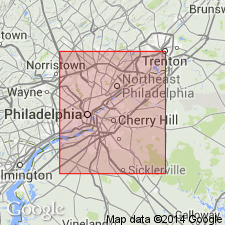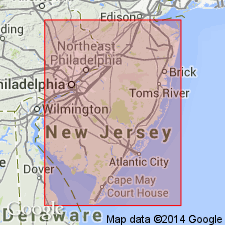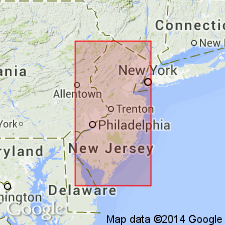
- Usage in publication:
-
- Glassboro gravel
- Modifications:
-
- Original reference
- Dominant lithology:
-
- Gravel
- AAPG geologic province:
-
- Atlantic Coast basin
Summary:
Pg. 296-309. Glassboro gravel. Called "Fossiliferous gravel" in earlier papers, because many of its pebbles are fossiliferous. Occurs at lower elevations than Bryn Mawr gravel. Abundant in New Jersey and southeast Pennsylvania. It is the yellow gravel which caps the watershed between the Atlantic and the Delaware at a height of nearly 200 feet. Is older than Philadelphia red gravel.
Probably named from occurrence at Glassboro, Gloucester Co., NJ.
Source: US geologic names lexicon (USGS Bull. 896, p. 824).

- Usage in publication:
-
- Glassboro phase
- Modifications:
-
- Revised
- AAPG geologic province:
-
- Atlantic Coast basin
Summary:
Pg. 11, 62. Used Glassboro phase of Bridgeton formation. See 1917 entry under Bridgeton formation.
Source: US geologic names lexicon (USGS Bull. 896, p. 824).

- Usage in publication:
-
- Glassboro gravel
- Modifications:
-
- Overview
- AAPG geologic province:
-
- Atlantic Coast basin
Summary:
Glassboro gravel is a part of Bridgeton formation, according to USGS Philadelphia folio (No. 162), 1909. Present in southeastern Pennsylvania and adjacent parts of New Jersey. Age is Pleistocene.
Source: US geologic names lexicon (USGS Bull. 896, p. 824).

- Usage in publication:
-
- Glassboro phase
- Modifications:
-
- Revised
- Dominant lithology:
-
- Sand
- Gravel
- Clay
- AAPG geologic province:
-
- Atlantic Coast basin
Summary:
Glassboro phase of Bridgeton (Salisbury and Knapp, 1917: New Jersey Geological Survey, v. 8) occurs south and west of line drawn from Berlin down Mullica River to Atlantic Coast. Phase includes greater part of formation and consists of fine sand and gravel with a few boulders and some clay.
Source: GNU records (USGS DDS-6; Reston GNULEX).
For more information, please contact Nancy Stamm, Geologic Names Committee Secretary.
Asterisk (*) indicates published by U.S. Geological Survey authors.
"No current usage" (†) implies that a name has been abandoned or has fallen into disuse. Former usage and, if known, replacement name given in parentheses ( ).
Slash (/) indicates name conflicts with nomenclatural guidelines (CSN, 1933; ACSN, 1961, 1970; NACSN, 1983, 2005, 2021). May be explained within brackets ([ ]).

